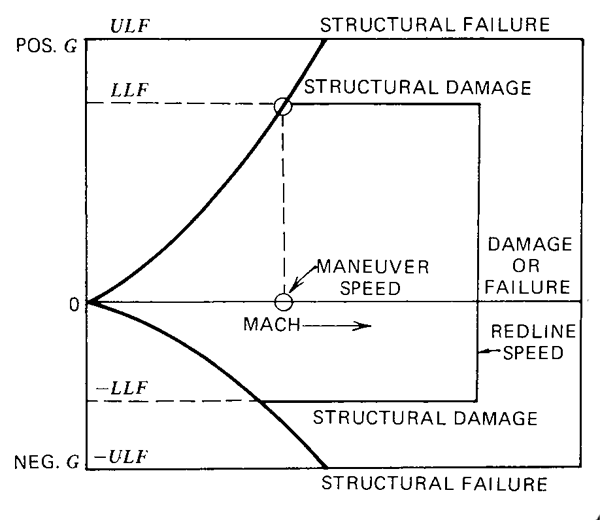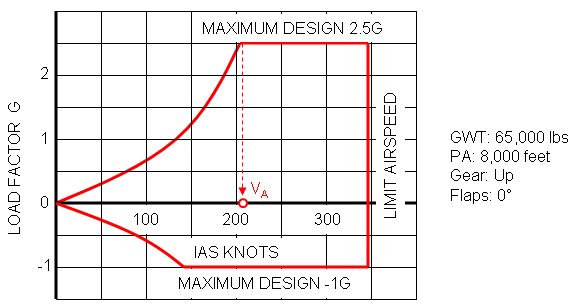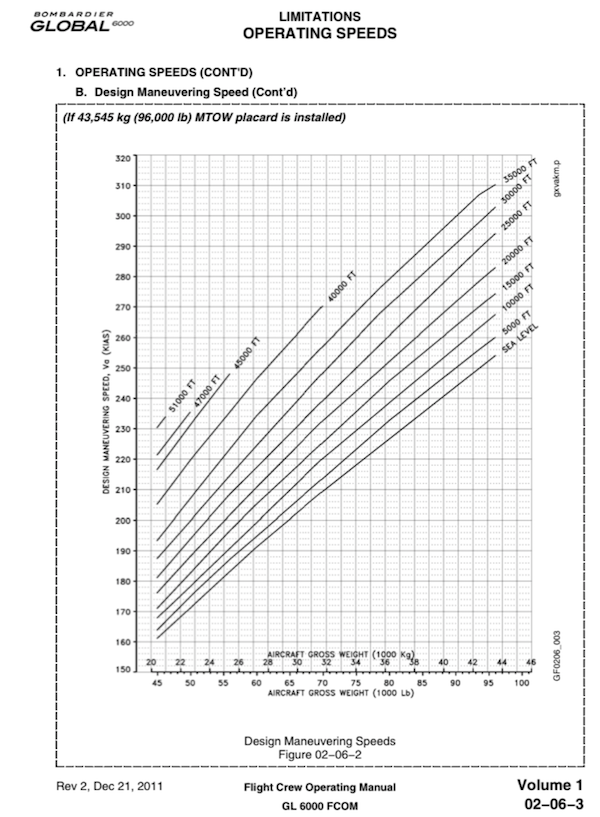Design maneuvering speed, VA, is a valuable tool in any fighter pilot's arsenal. Knowing how to extract the last bit of aerodynamic maneuverability can be a lifesaver in air-to-air combat. It is, however, a subject best left in the classroom for most transport category pilots. It is defined in 14 CFR 25.335 as simply the clean stall speed of an aircraft times the square root of its positive maneuvering load factor limit. Aircraft designers must consider it, but manufacturers are not constrained on how they present it. While the layman's translation of VA is the speed at which you cannot stall or over-stress an aircraft, manufacturers do not have to specify an altitude or weight at which they figured VA. Pilots are either left with a single number without the weight and altitude specified, or a chart that is hardly usable when the pilot wants to know a speed to fly.
— James Albright

Updated:
2014-10-19
There is limited benefit to a transport category pilot knowing a specific VA, and there is a real danger if pilots don't understand the true meaning of VA. The old maxim that you can "yank and bank to your heart's content at VA" is false. Pilots should understand:
- You can overstress the airplane at speeds below VA. The number is established in certification one axis at a time and does not consider combinations of inputs or rapid reversals. See Unusual Attitude Recovery.
- You can stall the airplane at speeds above VA. Your stall speed goes up with load factor, altitude, weight, etc. The next time you are in the simulator fly above VA, roll to 80° of bank and pull to maintain level flight. You will stall.
So what does this mean to us transport category pilots? Fly with some finesse, for every action there is a reaction, give the airplane time to talk back to you. (And listen!)

1
Regulatory
The published VA in your flight manual is a regulatory requirement from 14 CFR 25. It stipulates that the aircraft flaps are retracted but allows the manufacturer to choose a weight and altitude with no further conditions:
The selected design airspeeds are equivalent airspeeds (EAS). Estimated values of VS0 and VS1 must be conservative.
(c) Design maneuvering speed VA. For VA, the following apply:
(1) VA may not be less than VS1 √n where—
(i) n is the limit positive maneuvering load factor at VC ; and
(ii) VS1 is the stalling speed with flaps retracted.
(2) VA and VS must be evaluated at the design weight and altitude under consideration.
(3) VA need not be more than VC or the speed at which the positive CN max curve intersects the positive maneuver load factor line, whichever is less.
Source: 14 CFR 25.335
Note that 14 CFR 25 does not specify an altitude or weight for Va, but clearly the speed at which the aircraft will stall changes with both of these factors. While the regulation does specify a clean configuration, clearly you will also have different VAs for various gear and flap settings.
2
What it really means
An interesting point on the V-G diagram is the intersection of the aerodynamic limit line and the structural limit line. The aircraft's speed at this point is called the maneuver speed, commonly called the corner speed. At any speed below this speed the aircraft cannot be overstressed. It will stall before before the limit load factor is reached. Above this speed, however, the aircraft can exceed the limit load factor before it stalls. At the maneuver airspeed the aircraft's limit load factor will be reached at the lowest possible speed.
Source: Dole, pp. 193-194
From this explanation it becomes clear what matters to a pilot: VA is the speed below which the aircraft cannot be overstressed and above which the aircraft cannot be stalled. But aerodynamic texts that deal with this are usually written with smaller aircraft in mind and the theory breaks down in real life.
Even with smaller jet aircraft we were cautioned to be careful about combining inputs in two or three axis. When I was in the Air Force "yank and bank" community we lost more than a few aircraft to a pilot pulling more rolling G-forces than the aircraft could take. The pilot was within published G-limits, but dead nonetheless.
History has also taught us that the theory breaks down when reversing a control input.
See the case of: American Airlines Flight 587.
If you would like to know more about maneuvering speed and how it is computed, see: Operating Flight Strength.
3
Two examples
Gulfstream Example
Gulfstream does not give you anything more than this when it comes to maneuvering speed: VA = 206 knots. But you know that with the flaps up you have a 2.5G limit and your VA will be 1.58 VS and that with the flaps extended you have a 2.0G limit and a VA of 1.41 VS. You also know that you can always see your VREF on the display controller and that your VA will be 15% higher.
How do I know all this? I've drawn up several V-g diagrams and compared them to results on teh display controller. Is that definitive? No. Is it more information than I had before? Yes.
An Example from Bombardier
Global 6000:
If you don't have a ready display of a comparable speed you should come up with a mental crutch you can use in a pinch. I've never flown a Global 6000 but I would be tempted to say this: Maneuvering speed is equal to twice the grossweight (in thousands) plus the altitude (in thousands) plus 80. At 70,000 pounds and 20,000 feet, for example, VA is about 2(70) + 20 + 80 = 240 knots. Pretty close, eh? It's better than flailing around with no idea at all.
So how would I use this in real life? I think I would add it to my one hour checks, making note of what my VA is each hour.
Hey James! Are you really this paranoid?
Yes.
4
Misunderstanding VA can be fatal
A pilot's over-aggressive use of the rudder may have been abetted by the knowledge they were below design maneuvering speed. The case of American Airlines 587 provides a good case study:
- During this accident investigation, the Safety Board learned that many pilots might have an incorrect understanding of the meaning of the design maneuvering speed (VA) and the extent of structural protection that exists when the airplane is operated below this speed.
- From an engineering and design perspective, maneuvering speed is the maximum speed at which, from an initial 1 G flight condition, the airplane will be capable of sustaining an abrupt, full control input limited only by the stops or by maximum pilot effort. In designing airplanes to withstand these flight conditions, engineers consider each axis (pitch, roll, and yaw) individually and assume that, after a single full control input is made, the airplane is returned to stabilized flight conditions. Full inputs in more than one axis at the same time and multiple inputs in one axis are not considered in designing for these flight conditions.
- The American Airlines managing director of flight operations technical told the Safety Board, during a post accident interview, that most American Airlines pilots believed that the airplane would be protected from structural damage if alternating full rudder pedal inputs were made at an airspeed below maneuvering speed. The American Airlines A300 fleet standards manager confirmed this belief during testimony at the Board's public hearing for this accident. The Board notes that the American Airlines A300 Operating Manual contained only one reference to design maneuvering speed, which indicated that it was the turbulence penetration speed (270 knots). However, as evidenced by flight 587, cyclic rudder pedal inputs, even when made at airspeeds below maneuvering speed, can result in catastrophic structural damage.
- Existing regulations and guidance pertaining to maneuvering speed may have contributed to the misunderstanding regarding the degree of structural protection provided by operating below maneuvering speed. Title 14 CFR 25.1583, "Operating Limitations," lists maneuvering speed among the airspeed limitations that must be furnished to the pilots of transport-category airplanes and states that, along with maneuvering speed, pilots must also be furnished "with a statement that full application of rudder and aileron controls, as well as maneuvers that involve angles of attack near the stall, should be confined to speeds below this value." Although it is true that full control inputs should be confined to airspeeds below maneuvering speed, the statement in Section 25.1583 could also be read to incorrectly imply that an airplane could withstand any such inputs so long as they were made below maneuvering speed. The explanation of design maneuvering speed in AC61-23C, "Pilot's Handbook of Aeronautical Knowledge," may be even more misleading, stating that, "any combination of flight control usage, including full deflection of the controls, or gust loads created by turbulence should not create an excessive air load if the airplane is operated below maneuvering speed." This statement strongly—and incorrectly—suggests that, if multiple control inputs were made below maneuvering speed, the airplane would be protected against structural damage.
- The Safety Board has no reason to believe that the misunderstanding about maneuvering speed is limited to A300-600 pilots. As a result, the Safety Board concludes that there is a widespread misunderstanding among pilots about the degree of structural protection that exists when full or abrupt flight control inputs are made at airspeeds below the maneuvering speed. Therefore, the Safety Board believes that the FAA should amend all relevant regulatory and advisory materials to clarify that operating at or below maneuvering speed does not provide structural protection against multiple full control inputs in one axis or full control inputs in more than one axis at the same time.
More about this: American Airlines 587.
5
What's my VA?
Of course the immediate answer is a question: "Who cares?" So long as you fly your airplane with a degree of finesse you can feel and listen to how the airplane is reacting to your inputs. Being a great pilot you will of course never get close to the stall or G-limits.
I can think of one instance where being nearer to VA can come in handy for us not in the "Get in the bad guy's six" community. If you are in severe turbulence — turbulence so bad you fear structural damage — flying at VA can save your airplane (and hide).
- If your manufacturer gave you a table, like the Global Express shown earlier, it might not be a bad idea to have that handy.
- Gulfstream gave me a single number that is a lie, so no help there. But they also gave me an instrument right at eye level that can display VREF. I always leave it there, knowing VA is 15% higher. If the display controller says 200, for example, I know the closer to 230 knots I am the less likely I am to breaking something.
For other aircraft I can't help you other than to say you need to think about it. If you really don't have anything else available to you, it would be good to know a range of speeds.
References
(Source material)
14 CFR 25, Title 14: Aeronautics and Space, Federal Aviation Administration, Department of Transportation
Dole, Charles E., Flight Theory and Aerodynamics, 1981, John Wiley & Sons, Inc, New York, NY, 1981.


